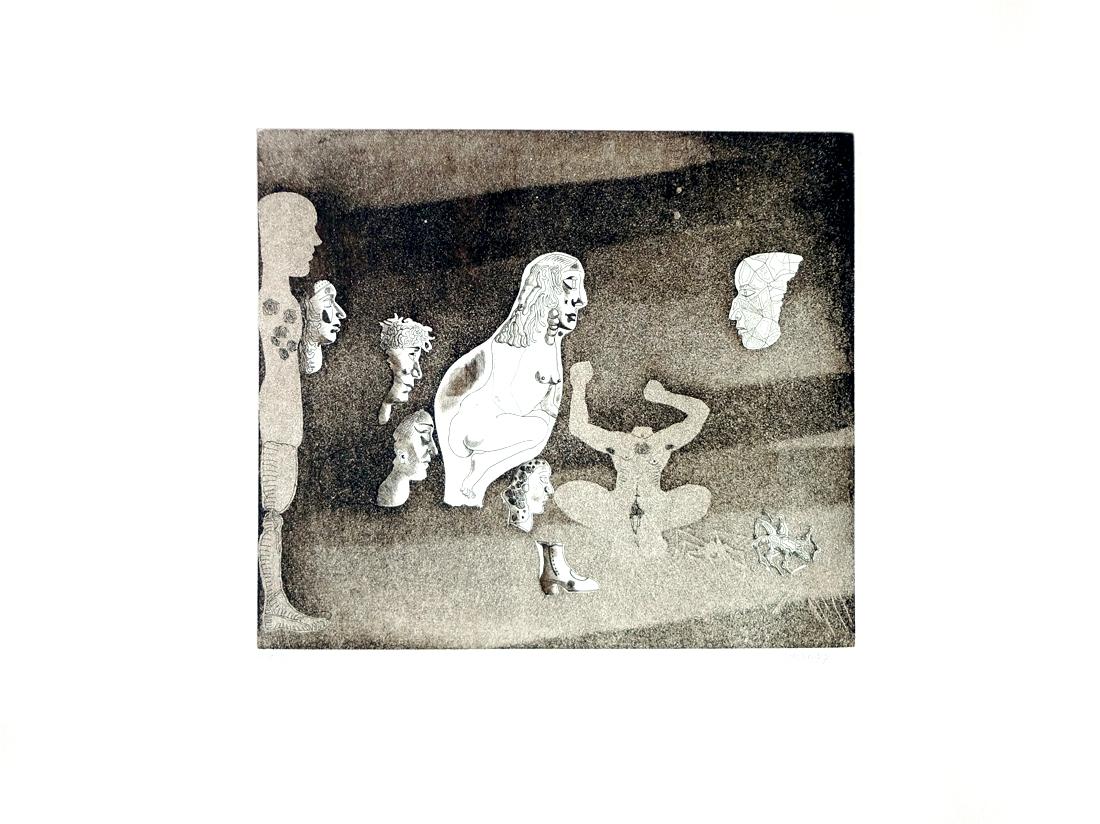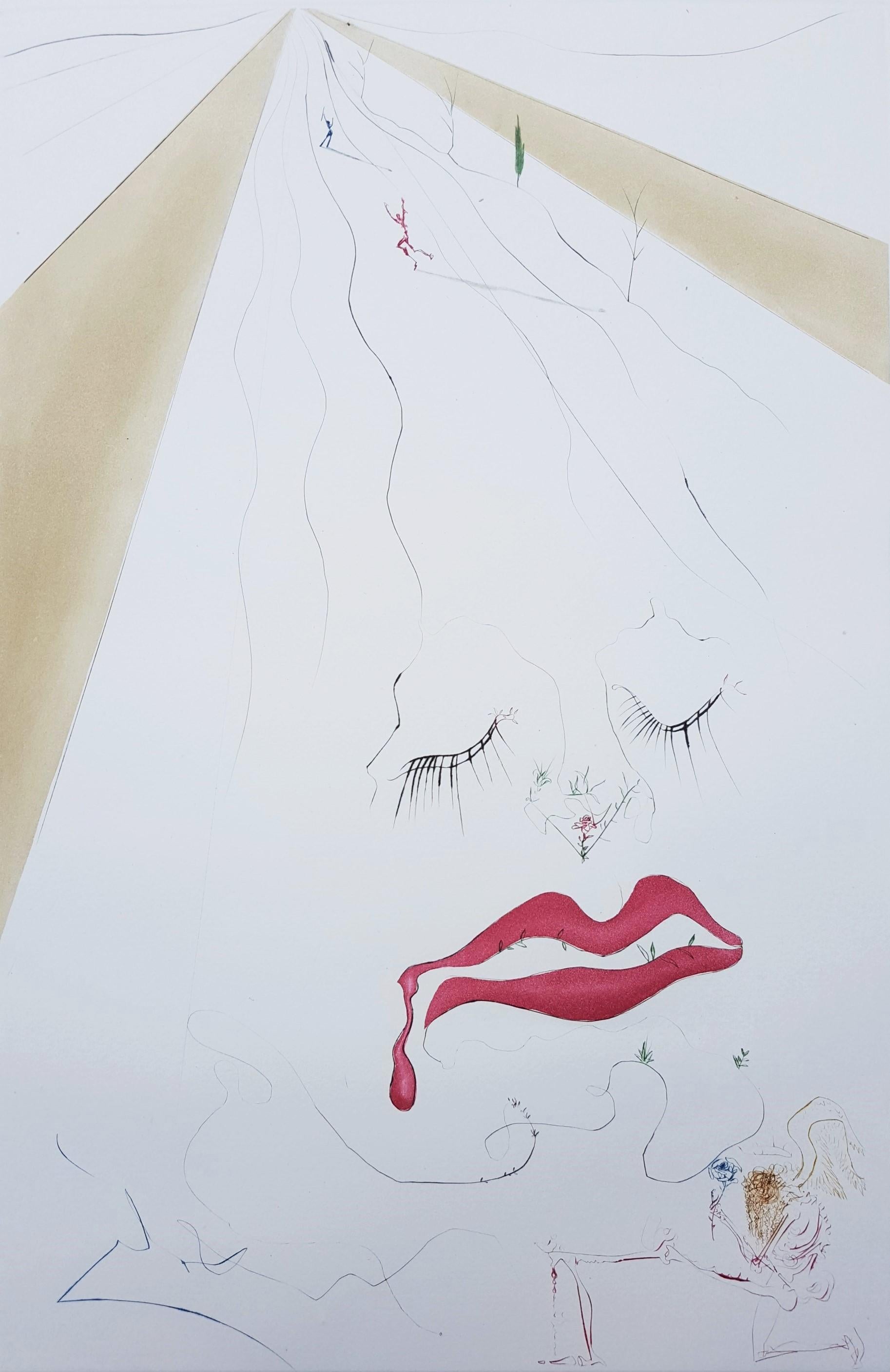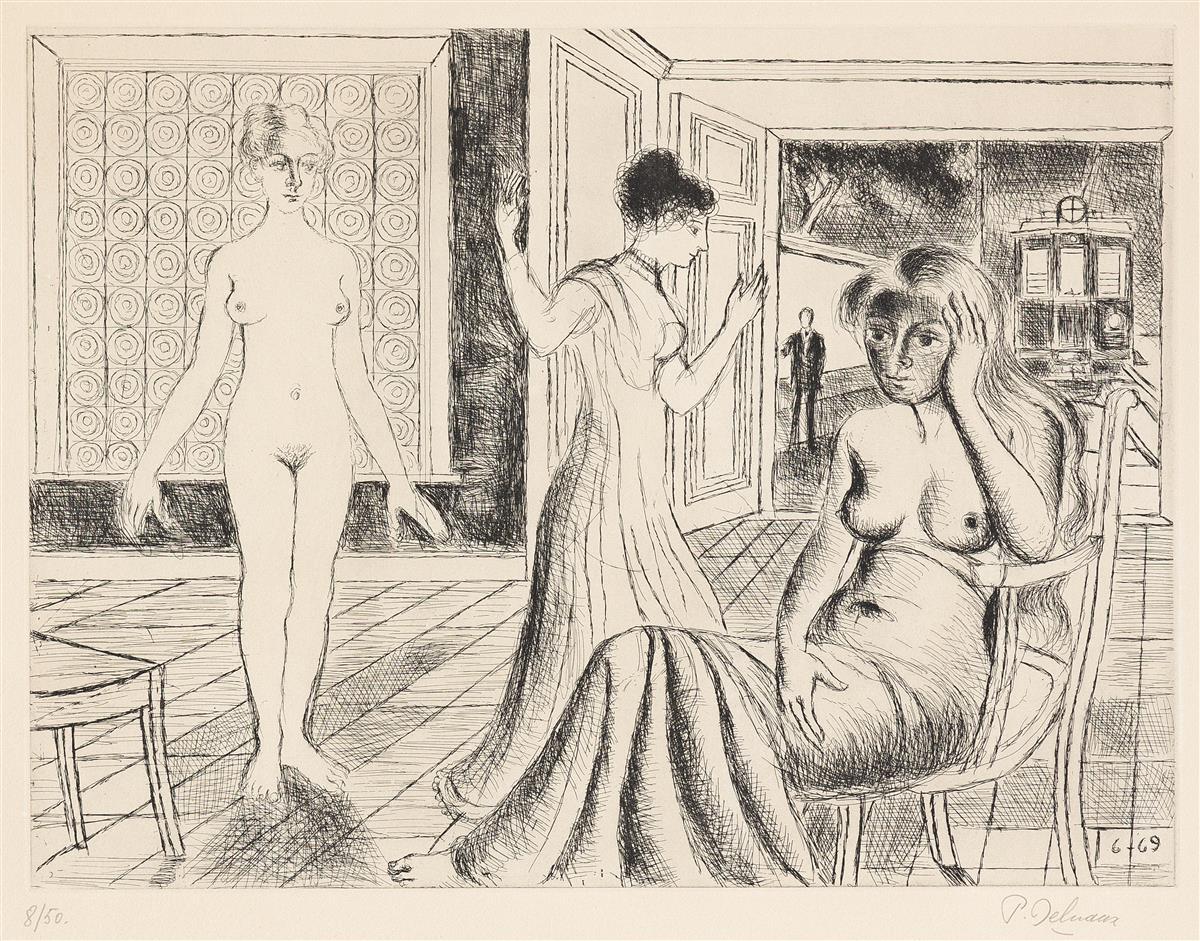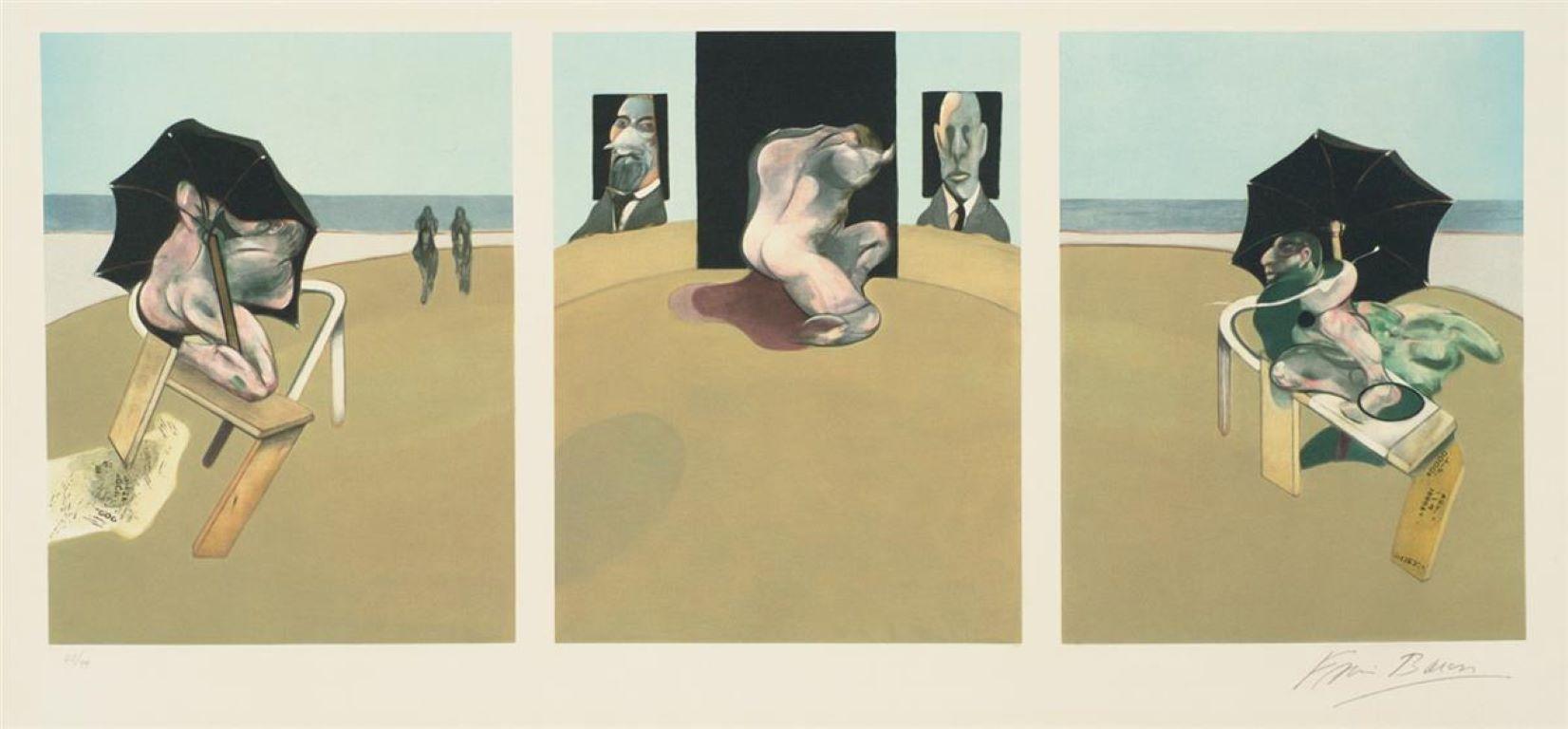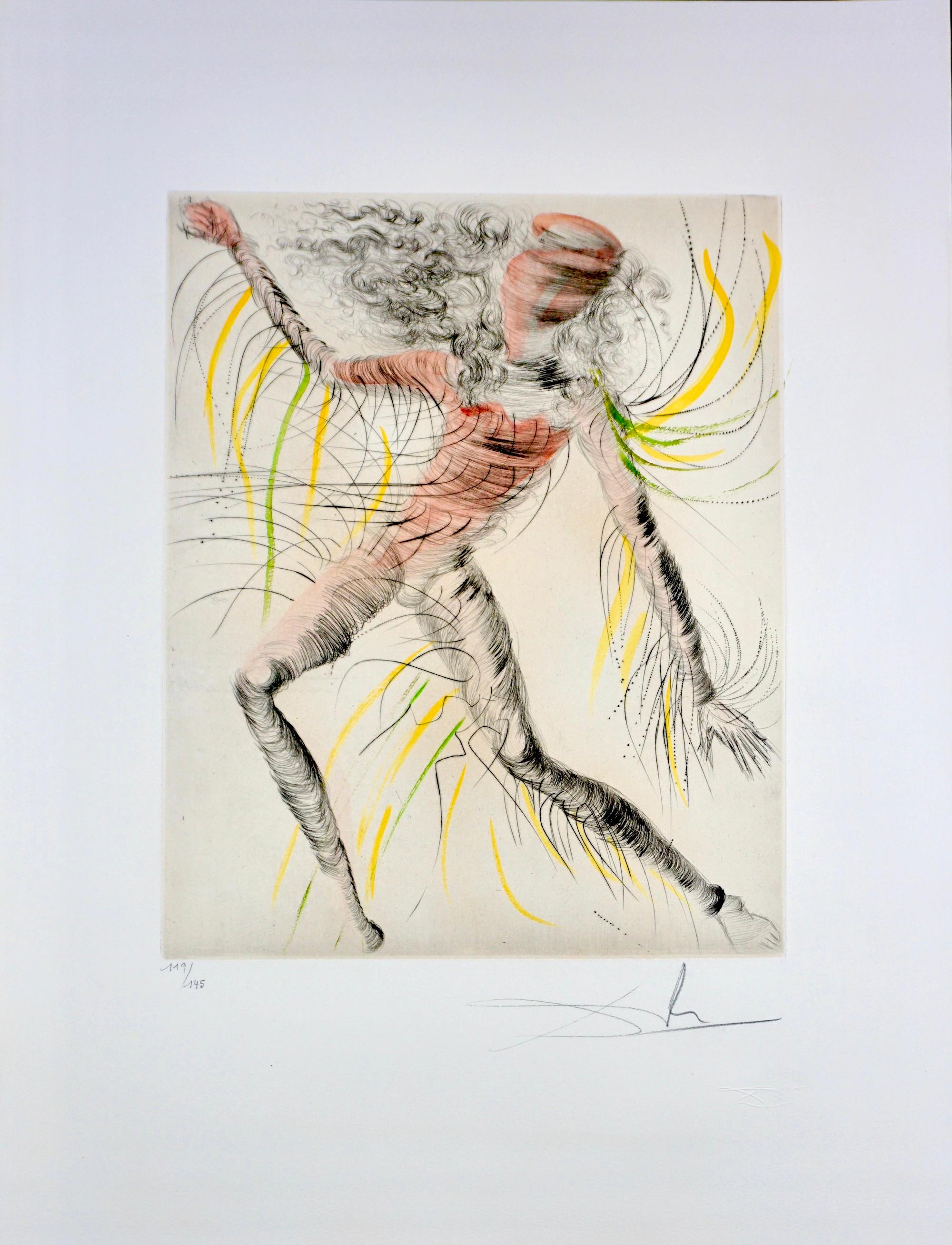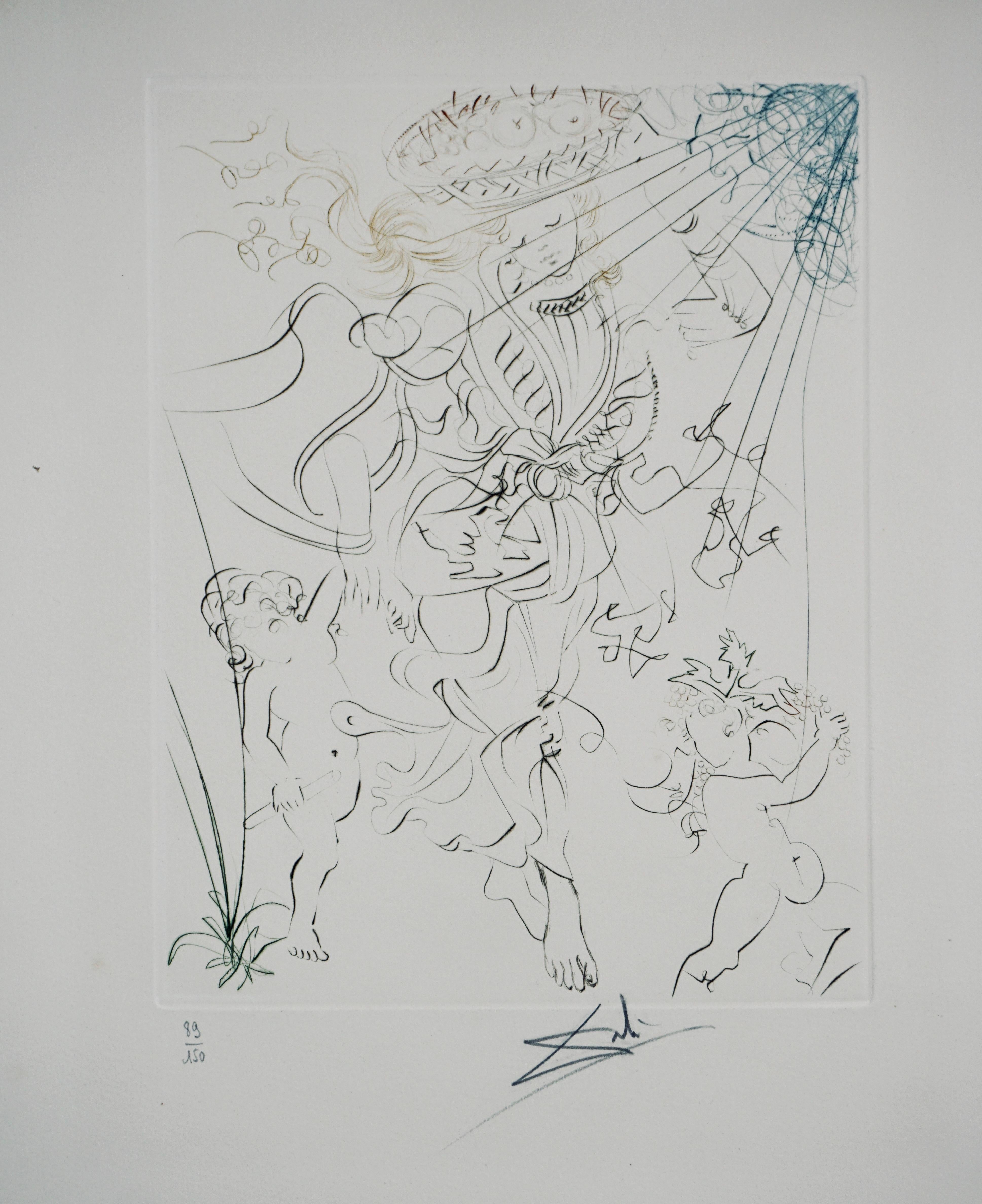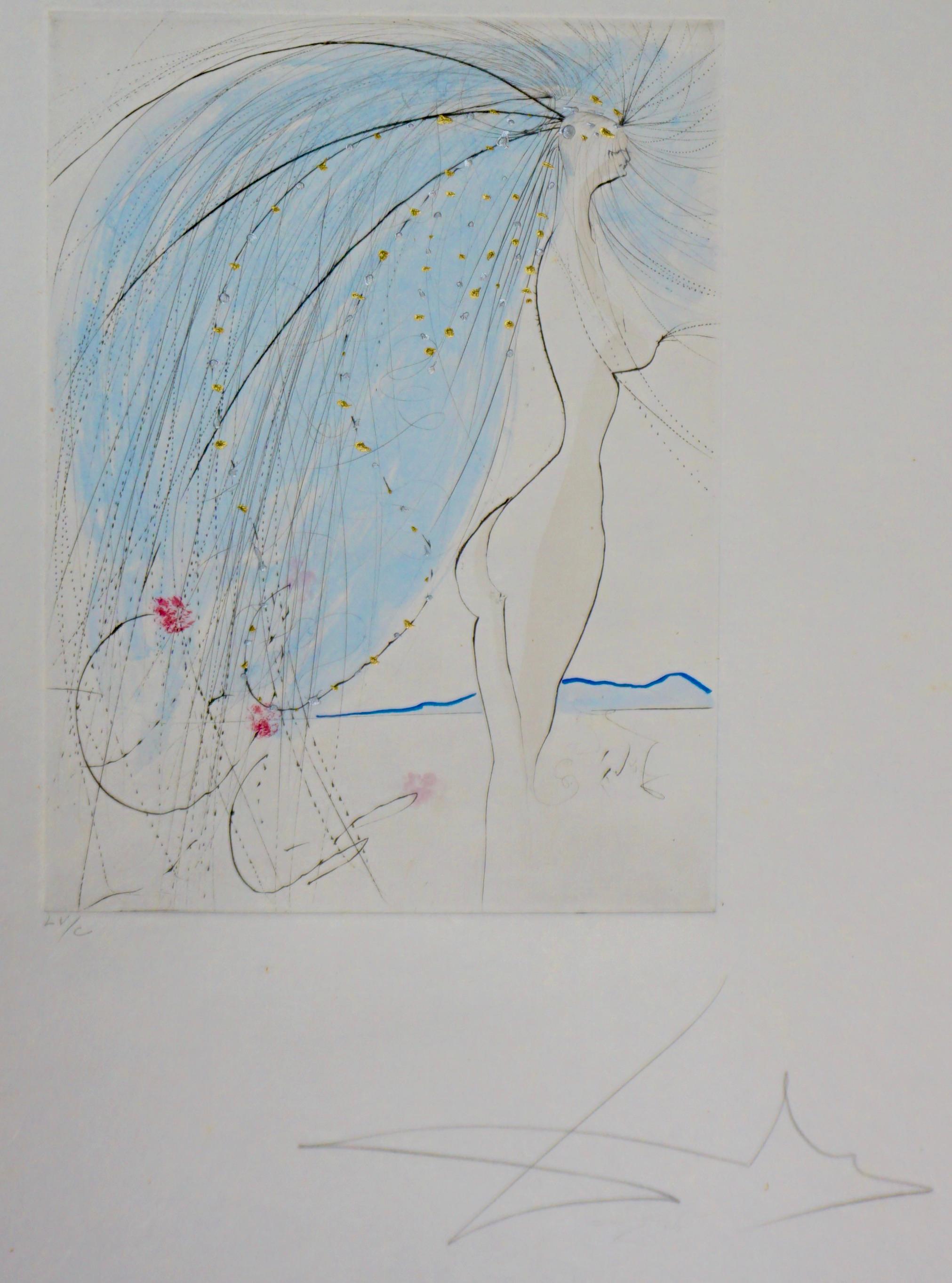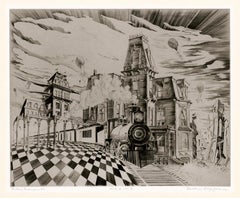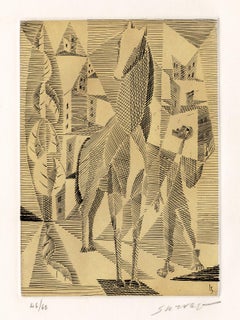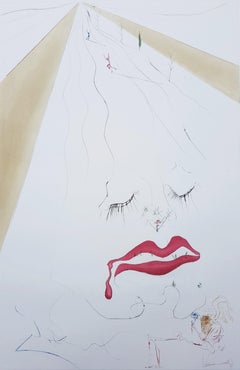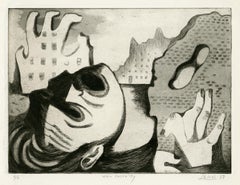
War Casualty — American Surrealism, Spanish Civil War, Anti-Fascism
View Similar Items
Leon BibelWar Casualty — American Surrealism, Spanish Civil War, Anti-Fascism1937
1937
About the Item
- Creator:Leon Bibel (1913 - 1995)
- Creation Year:1937
- Dimensions:Height: 7.38 in (18.75 cm)Width: 9.88 in (25.1 cm)
- Medium:
- Movement & Style:
- Period:
- Condition:
- Gallery Location:Myrtle Beach, SC
- Reference Number:Seller: 1021511stDibs: LU53239215552
Leon Bibel
Leon Bibel, a painter, printmaker and sculptor, was born in Poland in 1913 but moved with his family to San Francisco as a child. He trained at the California School of Fine Arts and received a scholarship to study under the German Impressionist Maria Riedelstein. He worked in collaboration with Bernard Zackheim, a student of Diego Rivera, to create frescoes for the San Francisco Jewish Community Center and the University of California Medical School. In 1936, Bibel moved from California to join the Federal Art Project of the New York City Work Projects Administration. He was assigned to the Graphic Art Project and the Easel Project at Harlem Art Center. He also taught at both PS 94 Kings College School and Bronx House in New York City. Bibel’s program in the WPA ended in 1941 and he moved with his wife to South Brunswick, New Jersey, ceasing his artistic pursuits to support his family. He resumed his artistic work in the early 1960s and continued to explore the mediums of painting and sculpture until his death. A constant innovator, Bibel experimented with diverse printmaking mediums. His work is distinguished by its boldly conceived, dramatic composition and passionately executed expressionist renderings. Bibel's parents immigrated from Poland and he remained staunchly pacifist, even throughout WWII. Much of his work during this period focused on the destructiveness of war and the consequent suffering and alienation of humankind. An artist of the people, his work is imbued with a sense of humanity and a concern for social justice and the plight of the working man. Bibel’s numerous exhibitions include the solo exhibition at Newark Museum in 1966, Jersey City Museum in 1967, Hunterdon Art Museum, Rutgers State University and New Jersey State Museum in 1978. He has also exhibited at Rider College, in 1983, Rutgers Hillel Foundation from 1985–86. His work is held in the permanent collections of the Metropolitan Museum of Art, the Museum of Fine Arts in Boston, the Newark Museum, the Zimmerli Art Museum of Rutgers, the Amon Carter Museum of American Art, the Klutznick Museum and the New Brunswick State Theater, as well as many corporate and private collections.
- 'Fantasia Americana - 1880' — Mid-Century American SurrealismBy Lawrence KupfermanLocated in Myrtle Beach, SCLawrence Kupferman, 'Fantasia Americana – 1880', drypoint etching with sandground, 1943. Signed, titled, and annotated 'Series A, 1971 2/6' in pencil. A superb, richly-inked impression, on heavy, cream wove paper, with full margins (2 1/2 to 3 1/2 inches); the paper slightly lightened within the original mat opening, otherwise in excellent condition. One of only 6 impressions printed in 1971, with the added sandground grey background tint. Image size 11 13/16 x 14 3/4 inches; sheet size 18 x 20 1/4 inches. Archivally matted to museum standards, unframed. Collections: National Gallery of Art, Zimmerli Art Museum (Rutgers University). ABOUT THE ARTIST Lawrence Kupferman (1909 - 1982) was born in the Dorchester neighborhood of Boston and grew up in a working-class family. He attended the Boston Latin School and participated in the high school art program at the Museum of Fine Arts, Boston. In the late 1920s, he studied drawing under Philip Leslie Hale at the Museum School—an experience he called 'stultifying and repressive'. In 1932 he transferred to the Massachusetts College of Art, where he first met his wife, the artist Ruth Cobb. He returned briefly to the Museum School in 1946 to study with the influential expressionist German-American painter Karl Zerbe. Kupferman held various jobs while pursuing his artistic career, including two years as a security guard at the Museum of Fine Arts, Boston. During the 1930s he worked as a drypoint etcher for the Federal Art Project, creating architectural drawings in a formally realistic style—these works are held in the collections of the Fogg Museum and the Smithsonian American Art Museum. In the 1940s he began incorporating more expressionistic forms into his paintings as he became progressively more concerned with abstraction. In 1946 he began spending summers in Provincetown, Massachusetts, where he met and was influenced by Mark Rothko, Hans Hofmann, Jackson Pollock, and other abstract painters. At about the same time he began exhibiting his work at the Boris Mirski Gallery in Boston. In 1948, Kupferman was at the center of a controversy involving hundreds of Boston-area artists. In February of that year, the Boston Institute of Modern Art issued a manifesto titled 'Modern Art and the American Public' decrying 'the excesses of modern art,' and announced that it was changing its name to the Institute of Contemporary Art (ICA). The poorly conceived statement, intended to distinguish Boston's art scene from that of New York, was widely perceived as an attack on modernism. In protest, Boston artists such as Karl Zerbe, Jack Levine, and David Aronson formed the 'Modern Artists Group' and organized a mass meeting. On March 21, 300 artists, students, and other supporters met at the Old South Meeting House and demanded that the ICA retract its statement. Kupferman chaired the meeting and read this statement to the press: “The recent manifesto of the Institute is a fatuous declaration which misinforms and misleads the public concerning the integrity and intention of the modern artist. By arrogating to itself the privilege of telling the artists what art should be, the Institute runs counter to the original purposes of this organization whose function was to encourage and to assimilate contemporary innovation.” The other speakers were Karl Knaths...Category
1940s Surrealist Figurative Prints
MaterialsDrypoint, Etching
- Le Cheval (The Horse) — Mid-Century CubismBy Léopold SurvageLocated in Myrtle Beach, SCLéopold Survage, 'Le Cheval' (The Horse), color etching, edition 60, 1953. Signed and numbered '46/60' in pencil. Initialed in the plate, lower right. A superb, richly-inked impressi...Category
1950s Surrealist Figurative Prints
MaterialsEtching
- 'On Stage' — Mid-Century Surrealism, Atelier 17Located in Myrtle Beach, SCIan Hugo, 'On Stage', from the portfolio 'Ten Engravings'. engraving, 1946, edition 50. Signed, dated, titled, and numbered '22/50' in pencil. A fine impression, with delicate overall plate tone, on cream wove paper, the full sheet with margins (3 5/8 to 4 7/8 inches), in excellent condition. With the blind stamp 'madeleine-claude jobrack EDITIONS', in the bottom right margin. Matted to museum standards, unframed. Image size 5 7/8 x 3 7/8 inches (149 x 98 mm); sheet size 15 1/8 x 11 1/8 inches (384 x 283 mm). Ian Hugo originally created "Ten Engravings" in 1945, and the portfolio included a foreword by his partner and collaborator, Anais Nin. In 1978, Hugo republished the portfolio with Madeleine-Claude Jobrack, an American master printmaker who studied under Stanley William Hayter at Atelier 17, Paris, and with Johnny Friedlaender. When Jobrack returned to the United States she managed the Robert Blackburn Printmaking Studio in New York before opening her own printing studio, Madeleine-Claude Jobrak Editions. “The sign of the true artist is one who creates a complete universe, invents new plants, new animals, new figures to transfer to us a new vision of the universe in which dream and reality fuse. Ian Hugo's plants have eyes, the birds have the delicacy of dragonflies, their feathers have the shape of fans. Humor is apparent in every gesture. He uses a fine spider web to give a feeling of flight, speed, lightness. The body of a woman reveals the structure of a leaf, a plant. Wings are moving in a world unified by mythological themes. This is an animated world, humorous and levitating, elusive and decorative, which by its unique forms and shapes gives us the sensation of a rebirth, a liberation from the usual, the familiar, a visit to a new planet.” —Anais Nin, from the forward to the portfolio ‘Ten Engravings’ ABOUT THE ARTIST Ian Hugo was born Hugh Parker Guiler in Boston, Massachusetts, on February 15, 1898. His childhood was spent in Puerto Rico—a "tropical paradise," the memory of which stayed with him and surfaced in both his engravings and his films. He attended school in Scotland and graduated from Columbia University where he studied economics and literature. Hugo was working with the National City Bank when he met and married author Anais Nin in 1923. The couple moved to Paris the following year, where Nin's diary and Guiler's artistic aspirations flowered. Guiler feared his business associates would not understand his interests in art and music, let alone those of his wife, so he began a second, creative life as Ian Hugo. Ian and Anais moved to New York in 1939. The following year he took up engraving and etching, working at Stanley William Hayter’s experimental printmaking workshop Atelier 17, established at the New School for Social Research. Hugo began producing surreal images often used to illustrate Nin's books. For Nin, his unwavering love and financial support were indispensable—Hugo was the "fixed center, core... my home, my refuge" (Sept. 16, 1937, Nearer the Moon, The Unexpurgated Diary of Anais Nin, 1937-!939). Fictionalized portraits of Higo and Nin appear in Philip Kaufman's 1990 film drama of a literary love triangle, Henry & June. Inspired by comments that viewers saw motion in his engravings, Hugo took up filmmaking. He asked the avant-garde filmmaker Sasha Hammid for instruction but was told, "Use the camera yourself, make your own mistakes, make your own style." Hugo embarked on an exploration of the film medium as a vehicle to delve into his dreams, his unconscious, and his memories. Without a specific plan, He would collect resonant images, then reorder or superimpose them, seeking a sense of self-connection through the poetic juxtapositions he created. These intuitive explorations resembled the mystical evocations of his engravings, which he described in 1946 as "hieroglyphs of a language in which our unconscious is trying to convey important, urgent messages." In the underwater world of his film ‘Bells of Atlantis,’ the light originates from the world above the surface; it is otherworldly, out of place, yet essential. In ‘Jazz of Lights,’ the street lights of Times Square become in Nin's words, "an ephemeral flow of sensations." This flow that she also calls "phantasmagorical" had a crucial impact on Stan Brakhage, who said that without Jazz of Lights (1954), "there would have been no Anticipation of the Night" his autobiographical film which ushered in a new era of experimental modernist filmmaking. Hugo lived the last two decades of his life in a New York apartment high above street level. In the evenings, surrounded by an electrically illuminated man...Category
1940s Surrealist Figurative Prints
MaterialsEngraving
- 'Early Marshes' — Mid-Century Surrealism, Atelier 17Located in Myrtle Beach, SCIan Hugo, 'Early Marshes', from the portfolio 'Ten Engravings'. engraving, 1943, edition 50. Signed, dated, titled, and numbered '37/50' in pencil. A fine impression, with delicate overall plate tone, on cream wove paper, the full sheet with margins (2 5/8 to 7 inches), in excellent condition. With the blind stamp 'madeleine-claude jobrack EDITIONS', in the bottom right margin. Matted to museum standards, unframed. Image size 5 x 5 7/8 inches (127 x 149 mm); sheet size 15 x 11 inches (381 x 279 mm). Ian Hugo originally created "Ten Engravings" in 1945 and the portfolio included a foreword by his partner and collaborator, Anais Nin. In 1978, Hugo republished the portfolio with Madeleine-Claude Jobrack, an American master printmaker who studied under Stanley William Hayter at Atelier 17, Paris, and with Johnny Friedlaender. When Jobrack returned to the States she managed the Robert Blackburn Printmaking Studio in New York before opening her own printing studio, Madeleine-Claude Jobrak Editions. “The sign of the true artist is one who creates a complete universe, invents new plants, new animals, new figures to transfer to us a new vision of the universe in which dream and reality fuse. Ian Hugo's plants have eyes, the birds have the delicacy of dragonflies, their feathers have the shape of fans. Humor is apparent in every gesture. He uses a fine spider web to give a feeling of flight, speed, lightness. The body of a woman reveals the structure of a leaf, a plant. Wings are moving in a world unified by mythological themes. This is an animated world, humorous and levitating, elusive and decorative, which by its unique forms and shapes gives us the sensation of a rebirth, a liberation from the usual, the familiar, a visit to a new planet.” —Anais Nin, from the forward to the portfolio ‘Ten Engravings’ ABOUT THE ARTIST Ian Hugo was born Hugh Parker Guiler in Boston, Massachusetts, on February 15, 1898. His childhood was spent in Puerto Rico—a "tropical paradise," the memory of which stayed with him and surfaced in both his engravings and his films. He attended school in Scotland and graduated from Columbia University where he studied economics and literature. Hugo was working with the National City Bank when he met and married author Anais Nin in 1923. The couple moved to Paris the following year, where Nin's diary and Guiler's artistic aspirations flowered. Guiler feared his business associates would not understand his interests in art and music, let alone those of his wife, so he began a second, creative life as Ian Hugo. Ian and Anais moved to New York in 1939. The following year he took up engraving and etching, working at Stanley William Hayter’s experimental printmaking workshop Atelier 17, established at the New School for Social Research. Hugo began producing surreal images often used to illustrate Nin's books. For Nin, his unwavering love and financial support were indispensable—Hugo was the "fixed center, core... my home, my refuge" (Sept. 16, 1937, Nearer the Moon, The Unexpurgated Diary of Anais Nin, 1937-!939). Fictionalized portraits of Higo and Nin appear in Philip Kaufman's 1990 film drama of a literary love triangle, Henry & June. Inspired by comments that viewers saw motion in his engravings, Hugo took up filmmaking. He asked the avant-garde filmmaker Sasha Hammid for instruction but was told, "Use the camera yourself, make your own mistakes, make your own style." Hugo embarked on an exploration of the film medium as a vehicle to delve into his dreams, his unconscious, and his memories. Without a specific plan, He would collect resonant images, then reorder or superimpose them, seeking a sense of self-connection through the poetic juxtapositions he created. These intuitive explorations resembled the mystical evocations of his engravings, which he described in 1946 as "hieroglyphs of a language in which our unconscious is trying to convey important, urgent messages." In the underwater world of his film ‘Bells of Atlantis,’ the light originates from the world above the surface; it is otherworldly, out of place, yet essential. In ‘Jazz of Lights,’ the street lights of Times Square become in Nin's words, "an ephemeral flow of sensations." This flow that she also calls "phantasmagorical" had a crucial impact on Stan Brakhage, who said that without Jazz of Lights (1954), "there would have been no Anticipation of the Night" his autobiographical film which ushered in a new era of experimental modernist filmmaking. Hugo lived the last two decades of his life in a New York apartment high above street level. In the evenings, surrounded by an electrically illuminated man...Category
1940s Surrealist Figurative Prints
MaterialsEngraving
- 'Together' — Mid-Century Surrealism, Atelier 17Located in Myrtle Beach, SCIan Hugo, 'Together', from the portfolio 'Ten Engravings'. engraving, 1946, edition 50. Signed, dated, titled, and numbered '22/50' in pencil. A fine impression, with delicate overall plate tone, on cream wove paper, the full sheet with wide margins (2 7/8 to 5 1/2 inches), in excellent condition. With the blind stamp 'madeleine-claude jobrack EDITIONS', in the bottom right margin. Matted to museum standards, unframed. Image size 5 7/8 x 4 7/8 inches (149 x 124 mm); sheet size 15 x 11 1/8 inches (381 x 283 mm). Collection: Indianapolis Museum of Art. Ian Hugo originally created "Ten Engravings" in 1945 and the portfolio included a foreword by his partner and collaborator, Anais Nin. In 1978, Hugo republished the portfolio with Madeleine-Claude Jobrack, an American master printmaker who studied under Stanley William Hayter at Atelier 17, Paris, and with Johnny Friedlaender. When Jobrack returned to the States she managed the Robert Blackburn Printmaking Studio in New York before opening her own printing studio, Madeleine-Claude Jobrak Editions. “The sign of the true artist is one who creates a complete universe, invents new plants, new animals, new figures to transfer to us a new vision of the universe in which dream and reality fuse. Ian Hugo's plants have eyes, the birds have the delicacy of dragonflies, their feathers have the shape of fans. Humor is apparent in every gesture. He uses a fine spider web to give a feeling of flight, speed, lightness. The body of a woman reveals the structure of a leaf, a plant. Wings are moving in a world unified by mythological themes. This is an animated world, humorous and levitating, elusive and decorative, which by its unique forms and shapes gives us the sensation of a rebirth, a liberation from the usual, the familiar, a visit to a new planet.” —Anais Nin, from the forward to the portfolio ‘Ten Engravings’ ABOUT THE ARTIST Ian Hugo was born Hugh Parker Guiler in Boston, Massachusetts, on February 15, 1898. His childhood was spent in Puerto Rico—a "tropical paradise," the memory of which stayed with him and surfaced in both his engravings and his films. He attended school in Scotland and graduated from Columbia University where he studied economics and literature. Hugo was working with the National City Bank when he met and married author Anais Nin in 1923. The couple moved to Paris the following year, where Nin's diary and Guiler's artistic aspirations flowered. Guiler feared his business associates would not understand his interests in art and music, let alone those of his wife, so he began a second, creative life as Ian Hugo. Ian and Anais moved to New York in 1939. The following year he took up engraving and etching, working at Stanley William Hayter’s experimental printmaking workshop Atelier 17, established at the New School for Social Research. Hugo began producing surreal images often used to illustrate Nin's books. For Nin, his unwavering love and financial support were indispensable—Hugo was the "fixed center, core... my home, my refuge" (Sept. 16, 1937, Nearer the Moon, The Unexpurgated Diary of Anais Nin, 1937-!939). Fictionalized portraits of Higo and Nin appear in Philip Kaufman's 1990 film drama of a literary love triangle, Henry & June. Inspired by comments that viewers saw motion in his engravings, Hugo took up filmmaking. He asked the avant-garde filmmaker Sasha Hammid for instruction but was told, "Use the camera yourself, make your own mistakes, make your own style." Hugo embarked on an exploration of the film medium as a vehicle to delve into his dreams, his unconscious, and his memories. Without a specific plan, He would collect resonant images, then reorder or superimpose them, seeking a sense of self-connection through the poetic juxtapositions he created. These intuitive explorations resembled the mystical evocations of his engravings, which he described in 1946 as "hieroglyphs of a language in which our unconscious is trying to convey important, urgent messages." In the underwater world of his film ‘Bells of Atlantis,’ the light originates from the world above the surface; it is otherworldly, out of place, yet essential. In ‘Jazz of Lights,’ the street lights of Times Square become in Nin's words, "an ephemeral flow of sensations." This flow that she also calls "phantasmagorical" had a crucial impact on Stan Brakhage, who said that without Jazz of Lights (1954), "there would have been no Anticipation of the Night" his autobiographical film which ushered in a new era of experimental modernist filmmaking. Hugo lived the last two decades of his life in a New York apartment high above street level. In the evenings, surrounded by an electrically illuminated man...Category
1940s Surrealist Figurative Prints
MaterialsEngraving
- 'Encircled' — Mid-Century Surrealism, Atelier 17Located in Myrtle Beach, SCIan Hugo, 'Encircled', engraving, 1946, edition 50. Signed, dated, titled, and numbered '5/50' in pencil. With the blind stamp 'madeleine-claude jobrack EDIT...Category
1940s Surrealist Figurative Prints
MaterialsEngraving
- Jorge Castillo - EROTIC COMPOSITION Etching on paper Spanish SurrealismBy Jorge CastilloLocated in Madrid, MadridJorge Castillo - COMPOSICIÓN ERÓTICA (Erotic Composition) Date of creation: 1977 Medium: Etching on paper Edition: 75 + 20 E.A. Size: 50 x 65,5 cm Condition: In perfect conditions an...Category
1970s Surrealist Figurative Prints
MaterialsEngraving, Etching
- Jorge Castillo - MARIENZA EN DOMINGO Etching Spanish Surrealism FeminineBy Jorge CastilloLocated in Madrid, MadridJorge Castillo - MARIENZA EN DOMINGO Date of creation: 1972 Medium: Etching on paper Edition: 150 + H.C. Size: 56 x 70 cm Condition: In perfect conditions and never framed Observatio...Category
1970s Surrealist Figurative Prints
MaterialsPaper, Engraving, Etching
- Transfiguration /// Surrealism Salvador Dali Landscape Etching Face Lips SurrealBy Salvador DalíLocated in Saint Augustine, FLArtist: Salvador Dali (Spanish, 1904-1989) Title: "Transfiguration" *Signed by Dali in pencil lower right Year: 1973 Medium: Original Etching on Auvergne paper Limited edition: 90/10...Category
1970s Surrealist Figurative Prints
MaterialsIntaglio, Etching
- La ChambreBy Paul DelvauxLocated in New York, NYA very good impression of this large and scarce etching. 1969. Signed and numbered 8/50 in pencil. Printed by Lacourière, Paris. Catalogue reference: Jacob 29Category
1960s Surrealist Figurative Prints
MaterialsEtching
- TriptychBy Francis BaconLocated in New York, NYVery good, well-inked impressions of these three color aquatints with etching on one sheet of Guarro paper. Signed and numbered 58/99 in pencil by Bacon. Printed and published by Pol...Category
1980s Surrealist Abstract Prints
MaterialsColor, Etching, Aquatint
$38,000 - The hippies The CosmonautBy Salvador DalíLocated in Hollywood, FLARTIST: Salvador Dali TITLE: The Hippies The Cosmonaut MEDIUM: Etching SIGNED: Hand Signed EDITION NUMBER: 119/145 MEASUREMENTS: 20" x 25.6" YEAR: 1969 CONDITION: Excellent ...Category
1960s Surrealist Figurative Prints
MaterialsEtching
